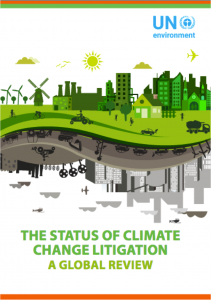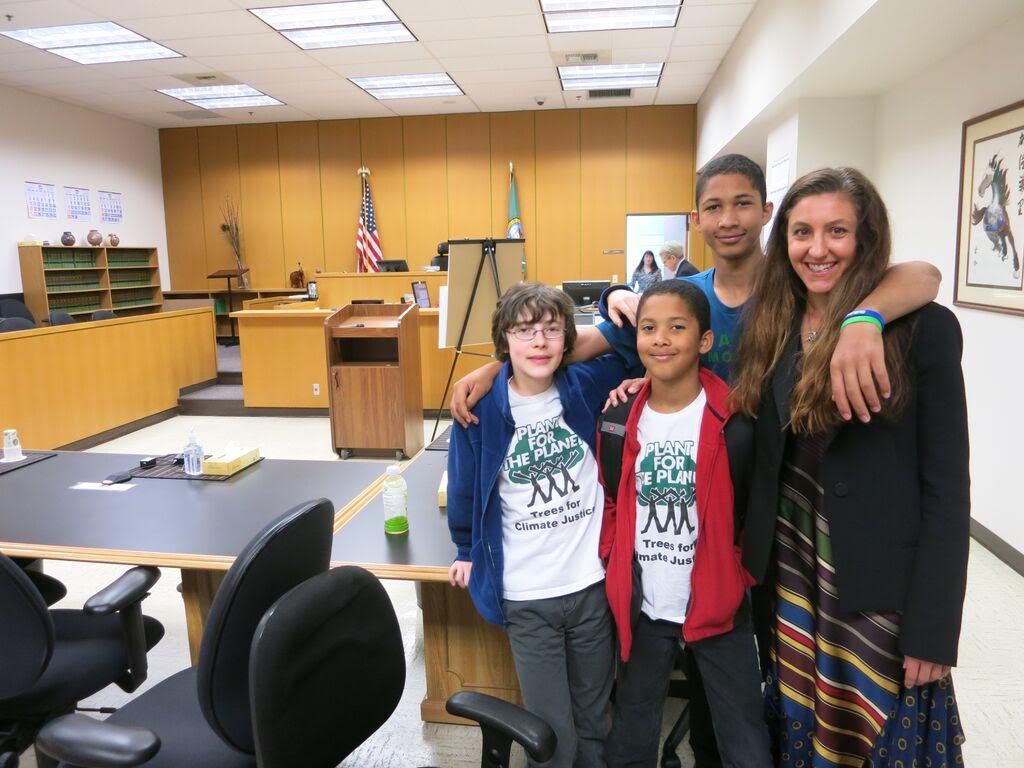By Mike Burger & Justin Gundlach
 Today, the Sabin Center and UN Environment have officially launched The Status of Climate Change Litigation – A Global Review. The report offers a (relatively) concise survey of decided and ongoing cases, an overview of salient trends, and descriptions of key issues that courts must resolve in the course of deciding different sorts of climate change cases. In addition to acting as a primer for those encountering climate change litigation for the first time, the report is also meant to provide researchers and practitioners with a basic conceptual framework and common source of terminology.
Today, the Sabin Center and UN Environment have officially launched The Status of Climate Change Litigation – A Global Review. The report offers a (relatively) concise survey of decided and ongoing cases, an overview of salient trends, and descriptions of key issues that courts must resolve in the course of deciding different sorts of climate change cases. In addition to acting as a primer for those encountering climate change litigation for the first time, the report is also meant to provide researchers and practitioners with a basic conceptual framework and common source of terminology.
The report’s timing is no coincidence. As various articles and analyses have observed, climate change litigation is becoming an increasingly prominent and significant feature of the climate law and policy landscape. This seems to be the natural consequence of a decade’s worth of increasingly concrete and meaningful legislation and regulation aimed at climate change—lawmaking that recognizes new rights, creates new duties, and is subject to challenge by parties seeking greater ambition from policymakers or adversely affected by new obligations and restrictions. As we explain below the jump, the growing prominence of climate change litigation also seems to owe to other factors as well, such as the Paris Agreement’s role in national-level climate change policymaking debates in countries other than the United States.
Our global climate change litigation report is divided into three parts:
The first part describes the environmental, diplomatic, and political circumstances that make climate change litigation efforts especially important at this moment. The most basic of these circumstances is physical: climate change impacts such as heat waves and destructive coastal storms are growing in frequency and severity, and scientists are becoming better able to specify the nature and degree of those impacts’ relationship to human-caused emissions. Another circumstance is political and economic: policymakers working at the national and international levels have struggled to deliver appropriately swift and sizeable mitigation and adaptation responses, and, taken as a group, continue to fall well short of targets that would be consistent with science-based climate change policies. On the other hand, those same policymakers have successfully created legal frameworks for climate action that the Paris Agreement has begun to stitch together into a global effort to avert severe climate damage. In combination, physical changes, improving technical understanding, and developing legal bases for action, make for fertile ground for litigants in climate change cases.
The second part of our report provides a numeric snapshot of where climate change litigation is taking place and describes several emerging litigation trends:
- Citizens and non-governmental organizations are suing to hold their governments accountable for climate-related commitments. In many instances, the arguments made to challenge government actions or inaction include reference to constitutional and statutory provisions not specific to climate change.
- Many challenges to a project or policy identify legally significant linkages between resource extraction and climate-related impacts, both in the form of emissions due to combustion of extracted fossil fuels and in the form of impairments to resiliency and adaptive capacity.
- Building on scientific understanding of the relationship between emissions and climate change, several cases seek to establish liability for entities that generate emissions with full knowledge of those emissions’ effects on the global climate.
- Steady improvements to the technical understanding of climate change and future temperature and weather patterns provide a strengthening basis for claims that seek to assign responsibility where failures to adapt result in foreseeable, material harms.
- Litigants are arguing for climate action based on the public trust doctrine, which assigns the state responsibility for the integrity of a nation’s public trust resources for future generations.
- More and more cases can be expected to arise as a result of growing rates of migration within and across national borders due to both slow-developing and acute environmental stresses.
- Litigants and courts in the Global South are beginning to make use of burgeoning climate change litigation theories and know how.
The third part of the report focuses on issues that tend to be disputed among litigants in climate change cases. It discusses those issues in three categories. Justiciability, i.e., whether a court has the authority to hear and resolve claims raised before it, is the first of these. Whether a case is justiciable turns on questions of the plaintiff’s standing and on the court’s role relative to that of the government’s other branches. Courts generally grant standing only after plaintiffs demonstrate that their alleged injury relates causally to the action (or inaction) complained of—potentially a high bar in climate change cases. As for courts’ relationship to other branches of government, particularly in cases that call on a court to assess inaction by a government, courts must be able to articulate what authority empowers them to find fault or direct the government’s political or administrative branches to take a different approach. The second issue-category is the source of legal obligations cited by litigants and courts. These might root in international law, constitutional provisions, statutes, regulations, and common law. Arguments over the relevance and applicability of these obligations most often arise where they do not expressly discuss climate change but nonetheless arguably call upon public or private actors to change their behavior. The third category of legal issues is remedies, which, in climate change cases, range from the conventional (e.g., compensation for a miscalculated obligation under an emissions trading scheme) to the monumental (e.g., a reformulation of national energy policy).
A full copy of the report is available here.
The press release announcing the report is here.




